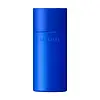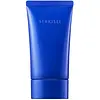What's inside
What's inside
 Key Ingredients
Key Ingredients

 Benefits
Benefits

 Concerns
Concerns

 Ingredients Side-by-side
Ingredients Side-by-side

Water
Skin ConditioningCyclomethicone
EmollientZinc Oxide
Cosmetic ColorantAlcohol
AntimicrobialEthylhexyl Methoxycinnamate
UV AbsorberC12-15 Alkyl Benzoate
AntimicrobialIsododecane
EmollientHdi/PPG/Polycaprolactone Crosspolymer
Tripropylene Glycol
AntioxidantDiethylamino Hydroxybenzoyl Hexyl Benzoate
UV FilterBis-Ethylhexyloxyphenol Methoxyphenyl Triazine
Skin ConditioningPropylene Glycol Dicaprate
EmollientAlpinia Speciosa Leaf Extract
Skin ConditioningCoix Lacryma-Jobi Ma-Yuen Seed Extract
Skin ConditioningGlycogen
HumectantMorinda Citrifolia Fruit Juice
Skin ConditioningOryza Sativa Bran Extract
Skin ConditioningPaeonia Albiflora Flower Extract
TonicBHT
AntioxidantButylene Glycol
HumectantEctoin
Skin ConditioningGlycerin
HumectantHydrated Silica
AbrasiveHydrogen Dimethicone
Isostearic Acid
CleansingSilica
AbrasiveSqualene
EmollientParfum
MaskingWater, Cyclomethicone, Zinc Oxide, Alcohol, Ethylhexyl Methoxycinnamate, C12-15 Alkyl Benzoate, Isododecane, Hdi/PPG/Polycaprolactone Crosspolymer, Tripropylene Glycol, Diethylamino Hydroxybenzoyl Hexyl Benzoate, Bis-Ethylhexyloxyphenol Methoxyphenyl Triazine, Propylene Glycol Dicaprate, Alpinia Speciosa Leaf Extract, Coix Lacryma-Jobi Ma-Yuen Seed Extract, Glycogen, Morinda Citrifolia Fruit Juice, Oryza Sativa Bran Extract, Paeonia Albiflora Flower Extract, BHT, Butylene Glycol, Ectoin, Glycerin, Hydrated Silica, Hydrogen Dimethicone, Isostearic Acid, Silica, Squalene, Parfum
Water
Skin ConditioningZinc Oxide
Cosmetic ColorantAlcohol Denat.
AntimicrobialEthylhexyl Methoxycinnamate
UV AbsorberCetyl Ethylhexanoate
EmollientIsododecane
EmollientDimethicone
EmollientBis-Ethylhexyloxyphenol Methoxyphenyl Triazine
Skin ConditioningDiethylamino Hydroxybenzoyl Hexyl Benzoate
UV FilterPolysilicone-15
UV FilterDipropylene Glycol
HumectantVinyl Dimethicone/Methicone Silsesquioxane Crosspolymer
Isotridecyl Isononanoate
EmollientAlpinia Uraiensis Leaf Extract
Skin ConditioningNelumbo Nucifera Flower Extract
Skin ConditioningBetula Alba Bark Extract
MaskingMalt Extract
Skin ProtectingPimpinella Anisum Seed Extract
AstringentMorinda Citrifolia Fruit Extract
Skin ConditioningLonicera Caerulea Fruit Juice
HumectantButylene Glycol
HumectantBHT
AntioxidantPEG-10 Hydrogenated Castor Oil
EmollientSodium Acrylate/Sodium Acryloyldimethyl Taurate Copolymer
Emulsion StabilisingVinyl Dimethicone/Lauryl Dimethicone Crosspolymer
Glyceryl Behenate/Eicosadioate
EmollientAlgin
MaskingIsohexadecane
EmollientSorbitan Oleate
EmulsifyingXanthan Gum
EmulsifyingCyclomethicone
EmollientSqualane
EmollientStearoyl Inulin
EmollientPolyglyceryl-10 Stearate
Skin ConditioningTriethoxycaprylylsilane
Trimethylsiloxysilicate
EmollientPolysorbate 80
EmulsifyingPolyhydroxystearic Acid
EmulsifyingPolyvinyl Alcohol
Polyvinyl Acetate
Emulsion StabilisingLauroyl Lysine
Skin ConditioningSynthetic Fluorphlogopite
Tin Oxide
AbrasivePhenoxyethanol
PreservativeParfum
MaskingTitanium Dioxide
Cosmetic ColorantWater, Zinc Oxide, Alcohol Denat., Ethylhexyl Methoxycinnamate, Cetyl Ethylhexanoate, Isododecane, Dimethicone, Bis-Ethylhexyloxyphenol Methoxyphenyl Triazine, Diethylamino Hydroxybenzoyl Hexyl Benzoate, Polysilicone-15, Dipropylene Glycol, Vinyl Dimethicone/Methicone Silsesquioxane Crosspolymer, Isotridecyl Isononanoate, Alpinia Uraiensis Leaf Extract, Nelumbo Nucifera Flower Extract, Betula Alba Bark Extract, Malt Extract, Pimpinella Anisum Seed Extract, Morinda Citrifolia Fruit Extract, Lonicera Caerulea Fruit Juice, Butylene Glycol, BHT, PEG-10 Hydrogenated Castor Oil, Sodium Acrylate/Sodium Acryloyldimethyl Taurate Copolymer, Vinyl Dimethicone/Lauryl Dimethicone Crosspolymer, Glyceryl Behenate/Eicosadioate, Algin, Isohexadecane, Sorbitan Oleate, Xanthan Gum, Cyclomethicone, Squalane, Stearoyl Inulin, Polyglyceryl-10 Stearate, Triethoxycaprylylsilane, Trimethylsiloxysilicate, Polysorbate 80, Polyhydroxystearic Acid, Polyvinyl Alcohol, Polyvinyl Acetate, Lauroyl Lysine, Synthetic Fluorphlogopite, Tin Oxide, Phenoxyethanol, Parfum, Titanium Dioxide
 Reviews
Reviews

Ingredients Explained
These ingredients are found in both products.
Ingredients higher up in an ingredient list are typically present in a larger amount.
BHT is a synthetic antioxidant and preservative.
As an antioxidant, it helps your body fight off free-radicals. Free-radicals are molecules that may damage your skin cells.
As a preservative, it is used to stabilize products and prevent them from degrading. Specifically, BHT prevents degradation from oxidation.
The concerns related to BHT come from oral studies; this ingredient is currently allowed for use by both the FDA and EU.
However, it was recently restricted for use in the UK as of April 2024.
Learn more about BHTYou might know this ingredient as Tinosorb S or Bemotrizinol. It is a UV filter that covers both UVA and UVB rays.
This ingredient has two peak UV absorption peaks ( 310 and 340 nm) and is able to absorb both UV-A and UV-B rays. This ingredient works by preventing UV rays from reaching and damaging your skin.
On top of that - it is highly photostable and helps prevent the photodegration of other sunscreen ingredients such as avobenzone.
Tinosorb S is allowed in the EU, Australia, and Asia. It is close to being approved by the FDA and we'll hopefully get this ingredient in the U.S. by late 2025.
Fun fact: Tinosorb S is the most effective UV absorber at maximum concentration (measured by SPF) permitted in the EU.
This ingredient is oil-soluble, so your oil-cleansers will take this right off at night.
Learn more about Bis-Ethylhexyloxyphenol Methoxyphenyl TriazineButylene Glycol (or BG) is used within cosmetic products for a few different reasons:
Overall, Butylene Glycol is a safe and well-rounded ingredient that works well with other ingredients.
Though this ingredient works well with most skin types, some people with sensitive skin may experience a reaction such as allergic rashes, closed comedones, or itchiness.
Learn more about Butylene GlycolCyclomethicone is a class of silicones used to improve the texture of products.
Their cyclic or circular structure decreases stability. This causes quick evaporation when applied to skin. Cyclomethicones are often used as a carrier for other ingredients. Once it evaporates, it leaves a silky barrier on the skin.
The most popular types of cyclomethicones include D5 and D6.
Learn more about CyclomethiconeDiethylamino Hydroxybenzoyl Hexyl Benzoate (DHHB) is a chemical UV-A absorber. It is formulated for high UVA protection (320-400 nm).
DHHB is well-liked for:
DHHB has been approved by the EU, Japan, Taiwan, and South America for use up to 10%. Unfortunately, it has not been approved for use in the US or Canada due to slow regulatory processes.
This ingredient is soluble in oils, fats, and lipids.
Learn more about Diethylamino Hydroxybenzoyl Hexyl BenzoateEthylhexyl Methoxycinnamate is an organic compound that provides UVB protection. It often goes by the more common name of octinoxate. It is created from methoxycinnamic acid and 2-ethylhexanol.
Ethylhexyl Methoxycinnamate absorbs UVB rays with wavelengths between 280-320 nm. UV absorbers protect your skin by using chemical reactions to convert UV rays into heat and energy.
UVB (290-320 nm) rays emit more energy than UVA rays. They are capable of damaging DNA, causing sunburns and are thought to be linked to skin cancer.
The state of Hawaii has banned sunscreens containing octinoxate due to its potential impact on coral reefs. More research is needed to bridge gaps in this research. The European Union allows higher levels of octinoxate in sunscreens than the US and Australia.
Ethylhexyl Methoxycinnamate is oil soluble. It is not stable and may lose efficacy when exposed to sunlight.
Learn more about Ethylhexyl MethoxycinnamateIsododecane is a fragrance, emollient, and solvent.
As an emollient, it helps your skin stay soft and hydrated. Emollients help trap moisture into your skin.
Isododecane's role as a solvent makes it a great texture enhancer. It spreads smoothly on skin and does not leave a sticky feeling behind. Isododecane also helps prevent color transfer in makeup products.
Isododecane is not absorbed into skin.
Learn more about IsododecaneParfum is a catch-all term for an ingredient or more that is used to give a scent to products.
Also called "fragrance", this ingredient can be a blend of hundreds of chemicals or plant oils. This means every product with "fragrance" or "parfum" in the ingredients list is a different mixture.
For instance, Habanolide is a proprietary trade name for a specific aroma chemical. When used as a fragrance ingredient in cosmetics, most aroma chemicals fall under the broad labeling category of “FRAGRANCE” or “PARFUM” according to EU and US regulations.
The term 'parfum' or 'fragrance' is not regulated in many countries. In many cases, it is up to the brand to define this term.
For instance, many brands choose to label themselves as "fragrance-free" because they are not using synthetic fragrances. However, their products may still contain ingredients such as essential oils that are considered a fragrance by INCI standards.
One example is Calendula flower extract. Calendula is an essential oil that still imparts a scent or 'fragrance'.
Depending on the blend, the ingredients in the mixture can cause allergies and sensitivities on the skin. Some ingredients that are known EU allergens include linalool and citronellol.
Parfum can also be used to mask or cover an unpleasant scent.
The bottom line is: not all fragrances/parfum/ingredients are created equally. If you are worried about fragrances, we recommend taking a closer look at an ingredient. And of course, we always recommend speaking with a professional.
Learn more about ParfumWater. It's the most common cosmetic ingredient of all. You'll usually see it at the top of ingredient lists, meaning that it makes up the largest part of the product.
So why is it so popular? Water most often acts as a solvent - this means that it helps dissolve other ingredients into the formulation.
You'll also recognize water as that liquid we all need to stay alive. If you see this, drink a glass of water. Stay hydrated!
Learn more about WaterZinc Oxide is a mineral broad-spectrum UV filter; it is the broadest UVA and UVB reflector approved by the FDA. It also has skin protectant and skin soothing properties.
Zinc oxide is one of the most effective broad-spectrum UV filters. It protects against UVB, UVAII, and UVAI. In comparison to its counterpart titanium dioxide, zinc oxide provides uniform and extended UVA protection.
Another great benefit? This ingredient is highly photostable so it won't degrade easily under sunlight.
A common myth is that mineral UV filters are widely believed to primarily reflect UV light.
However, modern research shows titanium dioxide absorbs UV radiation like chemical filters (~95% absorption & 5% reflection).
Zinc oxide has great skin soothing properties so you'll likely find this in sunscreens formulated for sensitive skin or babies/children. It is unlikely to cause "eye sting" like other sunscreen ingredients.
Regulatory agencies consider zinc oxide to be non-toxic and safe. It has also been shown to not penetrate the skin.
Unfortunately, this ingredient does leave a visible white cast. This is why mineral sunscreens are often less cosmetically elegant than chemical or hybrid ones.
In cosmetics, zinc oxide can be found in both non-nano and nano-sized forms. The nano version is used to reduce white cast and improve the texture of sunscreen formulas.
There are ongoing concerns surrounding nano-zinc oxide's impact on marine ecosystems and whether it can be absorbed into skin.
Regarding marine ecosystems and coral reefs, there is no conclusive evidence that any form of zinc oxide (or any other sunscreen ingredients) will cause harm. The science is still developing but many consumers are keeping a close eye on this issue.
Please note, many destinations have reef-safety sunscreen rules. For instance, the U.S. Virgin Islands advises all visitors to use non-nano mineral sunscreens.
There has also been some stir about whether micronized or nano zinc oxide has potential photoxicity and absorption through the skin/lungs.
An in-vitro (done in a test tube or petri dish) study demonstrated micronized zinc oxide to have potential phototoxicity. There's no need to fret; the EU Commission's Scientific Committee on Consumer Safety has stated, "The relevance of these findings needs to be clarified by appropriate investigations in vivo." Or in other words, further studies done on living organisms are needed to prove this.
Current research shows zinc oxide nanoparticles do not penetrate intact or sunburned skin. They either remain on the surface or in the outermost layer of dead skin (stratum corneum).
Zinc oxide is one of only two classified mineral UV filters with titanium dioxide being the other one.
Fun fact: Zinc has been used throughout history as an ingredient in paint and medicine. An Indian text from 500BC is believed to list zinc oxide as a salve for open wound. The Ancient Greek physician Dioscorides has also mentioned the use of zinc as an ointment in 1AD.
Learn more about Zinc Oxide